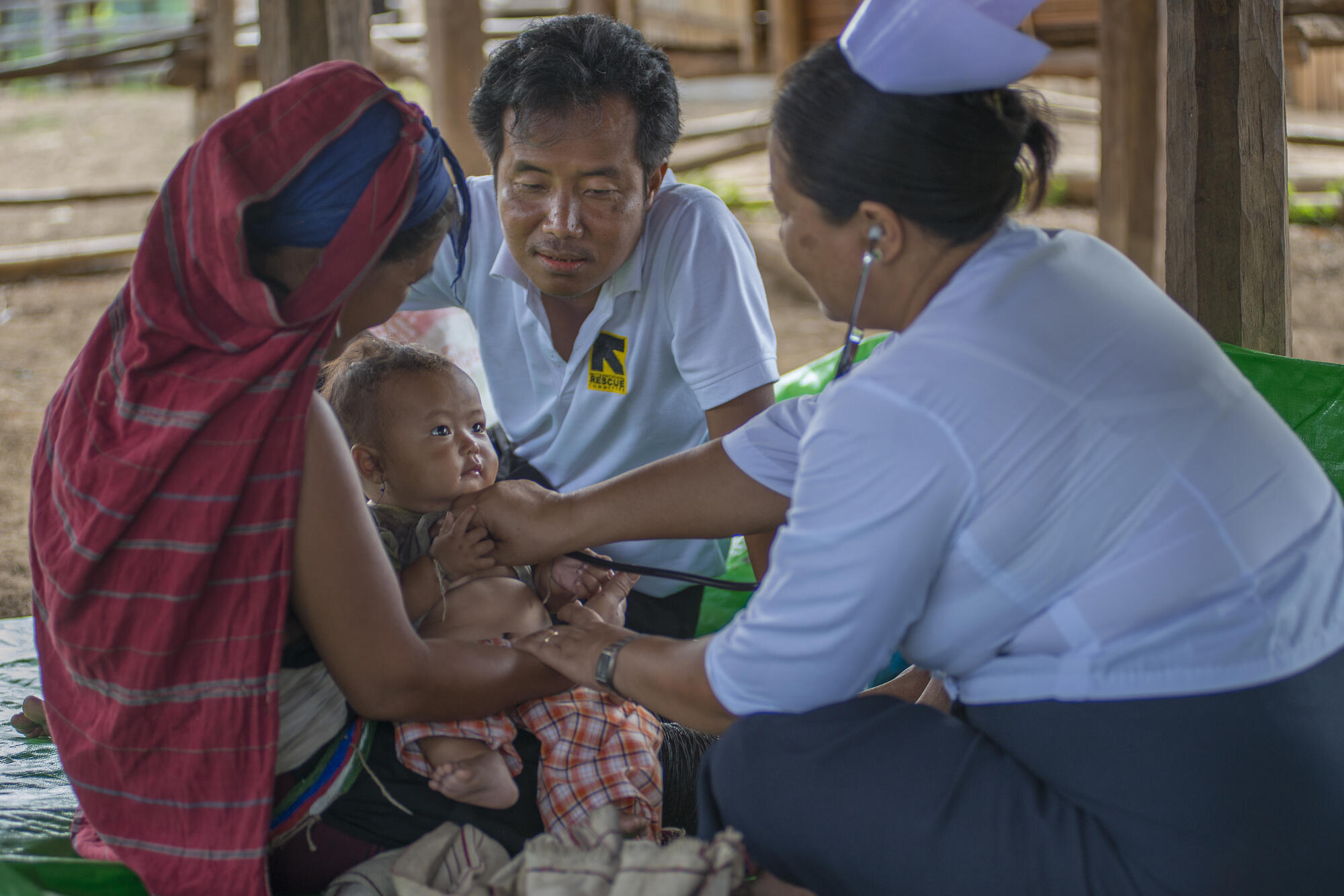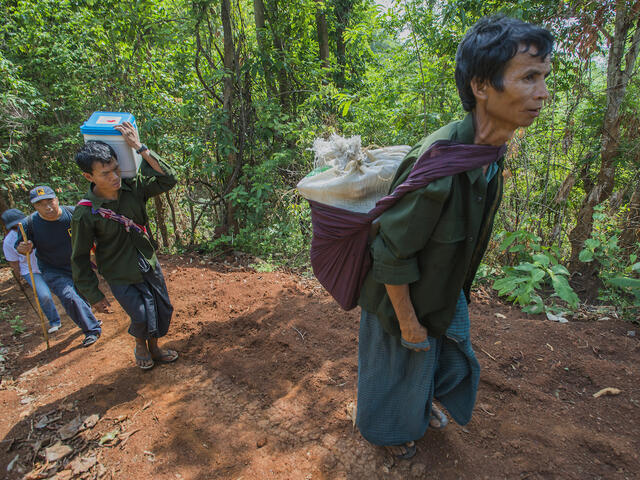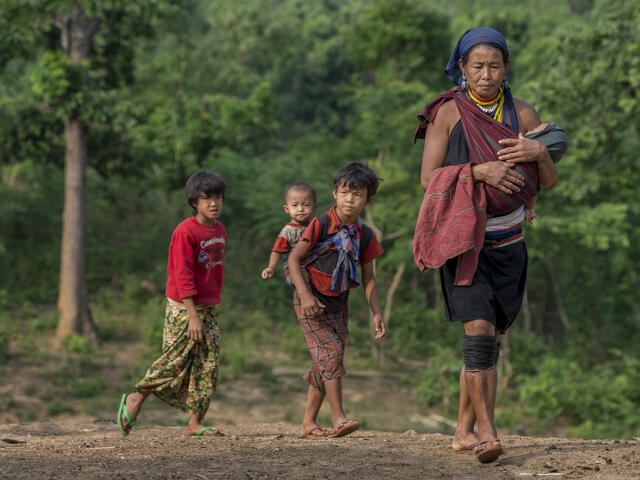
In 2012 after 60 years of conflict, the Myanmar government signed a ceasefire with Karenni rebel groups. The two sides are now working together for the first time, with support from the International Rescue Committee, bringing medicine and health care to former conflict zones. The IRC's Peter Biro reports from Karenni State in eastern Myanmar (also known as Burma).
This story was originally published in The Irrawaddy.
A merciless sun beats down from a cloudless sky and the tropical air feels like a thick, wet blanket. Flanked by dense foliage and large twisted vines, a small group of men and women march single-file along a narrow forest path in Karenni State in eastern Burma.
The group of a dozen nurses and medics are on their way to vaccinate children and bring medicine and health care to villages in a remote region that until recently was a fearsome war zone. Their mission is symbolic of the changes sweeping Burma, long considered a pariah state isolated from the rest of the world.
Half of the nurses and medics are employees of Burma’s Ministry of Health. The other half are associated with the Karenni National Progressive Party (KNPP), whose armed wing battled the Burma Army for more than 60 years until a ceasefire agreement between the two sides was signed in 2012. The long-running conflict, which involved a number of armed insurgent groups in addition to the KNPP, resulted in tens of thousands of civilians being displaced from their homes, mostly Karenni, one of the country’s many ethnic groups that have rebelled against central government control.

The joint health mission into the heart of the former conflict zone is one of the first fruits of the ceasefire and a larger peace process that participants hope will bring stability to a country that is still grappling with inter-communal violence, human rights abuses and economic inequality.
“This is a groundbreaking and unique moment, one many here never thought they would see,” says Shane Scanlon, of the International Rescue Committee (IRC), who is accompanying the group. The aid group has played a key role in training the Karenni medics and in arranging this joint mission.
“This is the first time that government and ethnic health organisations have joined forces, overcoming decades of mistrust borne of conflict,” he says.
The health workers recognise how unusual the composition of their team is and they are still feeling each other out, even as they march shoulder to shoulder into the forest.
“I was afraid to talk to the government health staff when we first met,” says Seh Reh, a Karenni medic. “There was a lot of suspicion. But working together and preparing for this trip has brought us closer together. Now we are learning from each other.”
As the noon sun reaches its zenith, the group approaches Daw Kleh Thae, a hamlet of thatched stilt houses surrounded by magnificent emerald hills. Until recently, the village was abandoned, houses burned down and fields fallow.
“The army came here and killed our cattle and destroyed our homes,” explains one local resident, Htwar Reh. “We were forced to live in the forest or flee to towns far away.”
With the signing of the ceasefire agreement, a small number of displaced civilians have been trickling back, some from Thailand, where they had been living in refugee camps.
“Most people are still afraid to return."
Nyunt Naing is an IRC doctor accompanying the mission. “But people tell us that seeing the government and the KNPP working together is increasing their confidence that the ceasefire will hold.”
The team quickly sets up a makeshift reception area and begins immunising children, administrating polio drops and screening for malnutrition, a major problem in this extremely impoverished area. Adults, some in colourful traditional dress, also line up, seeking treatment for a host of diseases, the most common of which are malaria and diarrhoea.

“We suffer here,” says one patient seeking treatment for a persistent fever. “We have no health centres in this area and there isn’t much food. It is very important for us to get this service."
Because of the conflict and the government’s previous neglect of the health system, government health workers have been unable to reach most people in Karenni State, one of the most isolated states in Burma. As a result, local residents here relied on the basic health services provided by opposition health workers from their bases in Thailand, or they used ineffective home remedies.
According to a 2010 study by Thailand-based medical groups, the most comprehensive available, this region of Burma suffers from some of the worst health indicators in the world. For example, women die in childbirth at three times the national average and one in seven children under the age of 5 dies from malnutrition or from treatable diseases such as diarrhoea and malaria.
“The joint health missions are good for everyone,” says Tun Aung Kyi, who oversees all health programmes in Karenni State for the Ministry of Health. “Health services are better and more effective.”
Marian Htoo, a government-employed midwife, has made five treks into the former combat zone. She says villagers would never have trusted her without the collaboration of the former resistance groups.
“Before, villagers were scared to show us whatever medicines they had at home,” she says. “They didn’t dare consult with us. Now it’s all changed.”
Preparing to leave Daw Kleh Thae, Scanlon adds, “This is the kind of trust that needs to be rebuilt between all sides, especially in communities that have been so scarred by war.
“Only then can the country see true, lasting peace.”